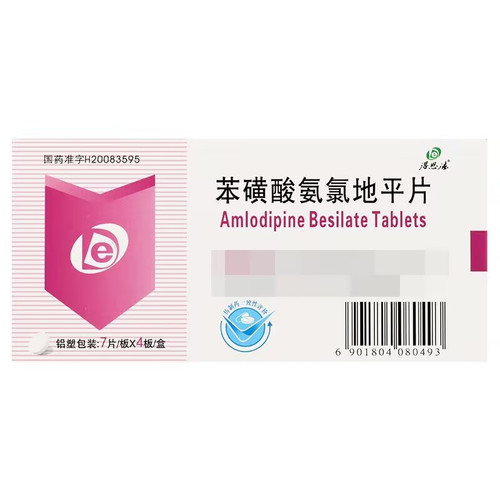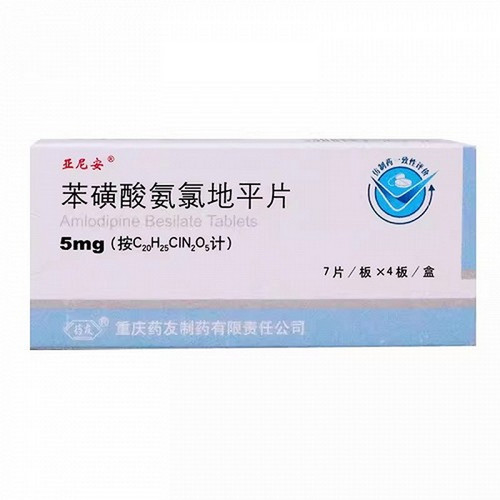Product Overview
[Generic Name]: Amlodipine Besylate Tablets
[Trade Name]: Shanyue
[English Name]: Amlodipine Besylate Tablets
[Chinese Pinyin]: Amlodipine Besylate Tablets
[Ingredients]: The main ingredient of this product is amlodipine.
[Appearance]: This product is a white tablet.
[Indications]: 1. Hypertension (used alone or in combination with other medications); 2. Angina pectoris: especially spontaneous angina (used alone or in combination with other medications).
[Dosage and Administration]: The usual starting oral dose is 5 mg once daily, with a maximum of 10 mg once daily. Patients of small stature, frail constitution, elderly patients, or those with impaired liver function should begin with 2.5 mg once daily. Patients taking other antihypertensive medications should also begin with this dose. The dosage should be adjusted based on individual needs, and the adjustment period should be at least 7-14 days to allow the physician to fully assess the patient's response to the dose. However, faster adjustment may be performed if clinically warranted. The recommended dose for the treatment of angina pectoris is 5-10 mg. A reduced dose is required for elderly patients or those with impaired liver function.
[Adverse Reactions]: This product is well tolerated within the 10 mg/day dose range, with most adverse reactions being mild to moderate. Discontinuation due to adverse reactions was only 1.5%, which was not significantly different from placebo (approximately 1%). The most common adverse reactions were headache and edema. Dose-related adverse reactions with an incidence of 1% were as follows: edema, dizziness, hot flashes, and palpitations. Adverse reactions with unclear dose relationships but an incidence exceeding 1.0% were as follows: headache, fatigue, nausea, abdominal pain, and somnolence. Among these adverse reactions, edema, hot flashes, palpitations, and somnolence were more common in women than in men. The following adverse events occurred at an incidence of <1% but 0.1% and the causal relationship to the drug is unclear: General: allergic reaction, asthenia, back pain, hot flashes, malaise, pain, stiffness, weight gain; Cardiovascular: arrhythmia (including tachycardia, bradycardia, or atrial fibrillation), chest pain, hypotension, peripheral ischemia, syncope, postural dizziness, postural hypotension, and vasculitis; Central and peripheral nervous system: hypoesthesia, peripheral neuropathy, paresthesia, tremor, vertigo; Gastrointestinal: anorexia, constipation, dyspepsia, dysphagia, diarrhea, flatulence, pancreatitis, vomiting, gingival hyperplasia; Musculoskeletal system: arthralgia, arthritis, muscle cramps, myalgia; Psychiatric: sexual dysfunction, insomnia, tension, depression, nightmares, anxiety, depersonalization; Skin and Appendages: Angioedema, erythema, pruritus, rash, maculopapular rash; Special Senses: Visual disturbances, conjunctivitis, diplopia, eye pain, tinnitus; Urinary System: Frequent urination, dysuria, nocturia; Autonomic Nervous System: Dry mouth, night sweats; Metabolism and Nutrition: Hyperglycemia, thirst; Hematopoietic System: Leukopenia, purpura, thrombocytopenia. The following adverse events occurred with an incidence of <0.1%: asthenia, irregular pulse, extrasystoles, skin discoloration, urticaria, dry skin, dermatitis, alopecia, muscle weakness, twitching, ataxia, hypertonia, migraine, cold and clammy skin, apathy, agitation, amnesia, gastritis, increased appetite, loose stools, cough, rhinitis, dysuria, polyuria, parosmia, taste disturbances, visual accommodation disturbances, and xerophthalmia. Other rare reactions, such as myocardial infarction and angina pectoris, cannot be distinguished as drug effects or disease states. Routine laboratory tests showed no significant changes, including no significant changes in serum potassium, blood glucose, triglycerides, total cholesterol, high-density lipoprotein (HDL), uric acid, blood urea nitrogen, or creatinine. Post-marketing, there have been occasional reports of gynecomastia in patients taking the drug, but the causal relationship with the drug is unclear. In some cases, jaundice and elevated liver enzymes (often accompanied by cholestasis and hepatitis) have been severe, requiring hospitalization.
[Contraindications]: Contraindicated in patients with hypersensitivity to dihydropyridine calcium channel blockers.
[Precautions]: 1. Angina and/or Myocardial Infarction: Rare. Patients with severe obstructive coronary artery disease may experience an increase in the frequency, duration, and/or severity of angina attacks, or the development of acute myocardial infarction, when initiating or increasing the dose of calcium channel blockers. The mechanism is unknown. 2. Hypotension: Due to the gradual vasodilatory effect of this drug, acute hypotension is generally rare with oral administration. However, caution is advised when using this drug in combination with other peripheral vasodilators, especially in patients with severe aortic valve stenosis. 3. Patients with heart failure: Calcium channel blockers should be used with caution in patients with heart failure. 4. Patients with hepatic impairment: This drug should be used with caution in patients with severe hepatic impairment.
[Precautions for Children]: Safety and efficacy in children have not been established.
[Precautions for Pregnancy and Lactation]: Research data on its use in pregnant women are lacking, but based on animal studies, this drug should only be used in pregnant women when absolutely necessary. It is unknown whether this drug is excreted in breast milk; breastfeeding women taking this drug should discontinue breastfeeding.
[Precautions for the Elderly]: Clinical studies have not demonstrated that elderly individuals respond differently to this drug than younger individuals. However, given that elderly individuals often have impaired liver, kidney, and heart function, as well as other medical conditions and medications, the lower end of the initial dose range is generally used. Elderly individuals have decreased clearance of this drug, with the area under the curve (AUC) increasing by approximately 40% to 60%, necessitating a lower initial dose.
[Drug Interactions]: Cimetidine, grapefruit juice, and acidogens: The pharmacokinetics of this drug are not altered when taken together. Atorvastatin, digoxin, and ethanol: This drug does not affect their pharmacokinetics. Sildenafil: A single dose of sildenafil (Viagra) has no effect on the pharmacokinetics of this drug in patients with essential hypertension. The two drugs produce an independent antihypertensive effect when taken together. Warfarin: This drug does not alter the prothrombin action time of warfarin. Digoxin, phenytoin, and warfarin: Coadministration with this drug has no effect on plasma protein binding. Anesthetics: Inhaled hydrocarbons may cause hypotension when taken together with this drug. Nonsteroidal anti-inflammatory drugs: Indomethacin, in particular, may attenuate the antihypertensive effect of this drug. Beta-blockers: Coadministration with this drug is well tolerated but may cause excessive hypotension and, rarely, worsen heart failure. Estrogens: Coadministration may cause fluid retention and increase blood pressure. Sulfinpyrazone: Concomitant use may increase the protein binding of this drug, resulting in changes in blood concentrations. Lithium: Concomitant use may cause neurotoxicity, resulting in nausea, vomiting, diarrhea, ataxia, tremor, and/or numbness; caution is advised. Sympathomimetic amines: May weaken the antihypertensive effect of this drug. Sublingual nitroglycerin and long-acting nitrate preparations: Concomitant use with this drug may enhance the antianginal effect. Although rebound effects have not been reported, the dose should be gradually reduced under a physician's guidance when discontinuing this drug. Thiazide diuretics, ACE inhibitors, digoxin, warfarin, antibiotics, and oral hypoglycemic agents: Can be safely used in combination with this drug.
[Pharmacological Action]: Amlodipine besylate is a dihydropyridine calcium antagonist (calcium ion antagonist or slow-channel blocker). Cardiac and smooth muscle contraction depends on the entry of extracellular calcium ions into cells through specific ion channels. This drug selectively inhibits the transmembrane entry of calcium ions into smooth muscle cells and cardiomyocytes, with a greater effect on smooth muscle than on myocardium. Its interaction with calcium channels is determined by the progressive rate of binding and dissociation from receptor sites, resulting in a gradual onset of pharmacological action. This product is a peripheral arterial dilator that acts directly on vascular smooth muscle, reducing peripheral vascular resistance and thereby lowering blood pressure. At therapeutic doses, negative inotropic effects have been observed in in vitro studies, but not in whole-animal studies. This product does not affect plasma calcium concentrations. 15 randomized, double-blind, placebo-controlled trials were conducted.
[Storage]: Store in a dark, sealed container.
[Specification]: 5mg*28
[Packaging]: Box
[Expiry Date]: 24 months.
[Approval Number]: National Medicine Standard H20113511
[Company Name]: Hunan Qianjin Xieli Pharmaceutical Co., Ltd.








